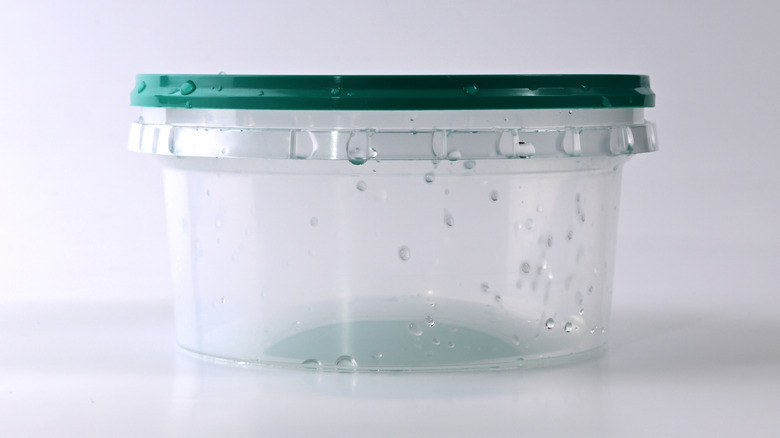Are Plastic Containers Still Coming Out Wet From The Dishwasher? Here's Why
If your dishwasher isn't drying your dishes, there might be something wrong with it. But, if your dishwasher just isn't drying your plastic containers, that's par for the course. This all-too-common issue is the result of the inherent properties of plastic, unfortunately, but there are still ways to counteract the problem.
To understand why seemingly every item in your dishwasher gets perfectly dry except your plastic containers, you first have to understand how dishwashers dry in the first place. Most dishwashers dry dishes by heating them with hot air, hot water, or both. This causes the water to evaporate from the dishes because water evaporates from a surface when the surface is hotter than the air around it.
But, plastic items are usually much lighter and less dense than ceramic, glass, or metal dishware, so they retain less heat. That means they cool down much more quickly, and less of the water is able to evaporate from the surface. The same problem can actually occur with other thin, light items, such as inexpensive aluminum trays.
Plastic is also hydrophobic
To make matters worse, plastics are hydrophobic, meaning they repel water from the surface (in part because plastics are made from oil and oil and water famously don't mix). When water comes into contact with a plastic container, it beads up. By contrast, ceramic, glass, and metal are hydrophilic — instead of beading up, water will form a thin layer on top.
Back to the evaporation process. The larger water droplets on plastic take longer to dry off than the evenly spread out water on other materials because less of the water is exposed to the air. When plastic containers get all scratched up, as they often do, water is even more prone to stick to them. And, plastic containers and lids also tend to have rims around the edge that cause water to pool.
So, how do you fix this issue? The solution starts before you even turn the dishwasher on. First, load plastic containers at an angle so they can more easily shed water and so water doesn't pool in any rims. Avoid overcrowding dishes, and remember to turn the heat setting on. Lastly, add a rinse aid. These contain ingredients that encourage water to run off of surfaces rather than bead up, and some rinse aids are designed specifically to help plastic dry.
More ways to dry plastic quickly
After the dishwasher is done running, open the door so the steam flows out and cool air is allowed in; the increased air circulation will speed up the drying process. If you leave the door closed for a while after the cycle finishes, the humidity can cause even more water droplets to form. Another potentially effective hack is to put a small towel over the door, with half of it inside. This may help wick moisture out of the dishwasher.
These efforts may not get your plasticware 100% dry, but they'll help combat the issue. To save time and get your plastic containers dried the rest of the way, keep a cloth on hand to wipe them down before putting them away. When it's time to replace your dishwasher, consider looking for one with a more efficient drying mechanism. For example, some higher-end brands use a fan to increase airflow, while others use granules called zeolites that absorb water and release heat to aid drying.
Remember that not all plastic should go in the dishwasher in the first place. For example, avoid placing polystyrene (with a #6 recycling label) in dishwashers. Check for a dishwasher-safe label. Only place plastic items on the top rack, where they're less likely to get deformed by the dishwasher's heating element, which is typically on the bottom.


